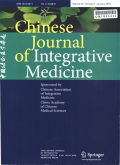- 钛学术文献服务平台 \
- 学术期刊 \
- 医药卫生期刊 \
- 中国医学期刊 \
- 中国结合医学杂志(英文版)期刊 \
null
A Survey of Application of Complementary and Alternative Medicine in Chinese Patients with Parkinson's Disease: A Pilot Study
基本信息来源于合作网站,原文需代理用户跳转至来源网站获取
摘要:
Objective:To investigate the prevalence and spectrum of complementary and alternative medicine (CAM) application and its related-factors in Parkinson's disease (PD) patients in China.Methods:A structured questionnaire regarding the use of CAMs was administered to PD patients by face-to-face interview.Demographic and social variables,clinical characteristics and treatments,and the related factors of PD were also surveyed.Results:Ninety out of 113 patients (79.6%) reported that they had received CAMs treatment,of which 48.6% (55/113) patients had received CAMs treatment for PD.The top 3 kinds of CAMs for PD were Chinese materia medica,rehabilitation exercise,and acupuncture ordinally.The source of information regarding CAMs treatment mainly came from relatives and friends (51.8%,73 cases),followed by physicians (31.9%,45 cases),and medias such as television,newspapers or the intemet (16.3%,28 cases).Fifty percent of CAM users reported a good therapeutic efficacy,whereas 39% patients reported that they felt neither better nor worse after the treatment,while 11% patients claimed worsening of symptoms.Multiple correspondence analyses survey found the main factors affecting the selectivity of CAMs ranked in the following order:income,education,occupation,habitation,age at onset,Hoehn and Yahr staging,PD duration,and gender.Conclusion:CAMs,especially Chinese materia medica,rehabilitation exercise,and acupuncture,are widely used for PD patients in China.

推荐文章
期刊_丙丁烷TDLAS测量系统的吸收峰自动检测
带间级联激光器
调谐半导体激光吸收光谱
雾剂检漏 中红外吸收峰 洛伦兹光谱线型
不同盐度、温度及光照对漂浮浒苔生理生态的影响
浒苔
盐度
温度
光照
生理生态
期刊_联合空间信息的改进低秩稀疏矩阵分解的高光谱异常目标检测
高光谱图像
异常目标检测 低秩稀疏矩阵分解 稀疏矩阵 残差矩阵
内容分析
关键词云
关键词热度
相关文献总数
(/次)
(/年)
文献信息
| 篇名 | A Survey of Application of Complementary and Alternative Medicine in Chinese Patients with Parkinson's Disease: A Pilot Study | ||
| 来源期刊 | 中国结合医学杂志(英文版) | 学科 | |
| 关键词 | |||
| 年,卷(期) | 2020,(3) | 所属期刊栏目 | |
| 研究方向 | 页码范围 | 168-173 | |
| 页数 | 6页 | 分类号 | |
| 字数 | 语种 | 英文 | |
| DOI | 10.1007/s11655-018-2560-y | ||
五维指标
引文网络
引文网络
二级参考文献 (0)
共引文献 (0)
参考文献 (20)
节点文献
引证文献 (0)
同被引文献 (0)
二级引证文献 (0)
1967(1)
- 参考文献(1)
- 二级参考文献(0)
1986(1)
- 参考文献(1)
- 二级参考文献(0)
1992(1)
- 参考文献(1)
- 二级参考文献(0)
1998(1)
- 参考文献(1)
- 二级参考文献(0)
2001(1)
- 参考文献(1)
- 二级参考文献(0)
2002(2)
- 参考文献(2)
- 二级参考文献(0)
2005(1)
- 参考文献(1)
- 二级参考文献(0)
2006(2)
- 参考文献(2)
- 二级参考文献(0)
2009(3)
- 参考文献(3)
- 二级参考文献(0)
2010(4)
- 参考文献(4)
- 二级参考文献(0)
2011(1)
- 参考文献(1)
- 二级参考文献(0)
2013(2)
- 参考文献(2)
- 二级参考文献(0)
2020(0)
- 参考文献(0)
- 二级参考文献(0)
- 引证文献(0)
- 二级引证文献(0)
引文网络交叉学科
相关学者/机构
期刊影响力
中国结合医学杂志(英文版)
主办单位:
中国中西医结合学会
中国中医研究院
出版周期:
月刊
ISSN:
1672-0415
CN:
11-4928/R
开本:
大16开
出版地:
北京西苑操场1号
邮发代号:
82-825
创刊时间:
1995
语种:
eng
出版文献量(篇)
2643
总下载数(次)
0
总被引数(次)
8415
期刊文献
相关文献
推荐文献
- 期刊分类
- 期刊(年)
- 期刊(期)
- 期刊推荐
中国结合医学杂志(英文版)2022
中国结合医学杂志(英文版)2021
中国结合医学杂志(英文版)2020
中国结合医学杂志(英文版)2019
中国结合医学杂志(英文版)2018
中国结合医学杂志(英文版)2017
中国结合医学杂志(英文版)2016
中国结合医学杂志(英文版)2015
中国结合医学杂志(英文版)2014
中国结合医学杂志(英文版)2013
中国结合医学杂志(英文版)2012
中国结合医学杂志(英文版)2011
中国结合医学杂志(英文版)2010
中国结合医学杂志(英文版)2009
中国结合医学杂志(英文版)2008
中国结合医学杂志(英文版)2007
中国结合医学杂志(英文版)2006
中国结合医学杂志(英文版)2005
中国结合医学杂志(英文版)2004
中国结合医学杂志(英文版)2003
中国结合医学杂志(英文版)2002
中国结合医学杂志(英文版)2001
中国结合医学杂志(英文版)2000
中国结合医学杂志(英文版)1999
中国结合医学杂志(英文版)1998
中国结合医学杂志(英文版)2020年第9期
中国结合医学杂志(英文版)2020年第8期
中国结合医学杂志(英文版)2020年第7期
中国结合医学杂志(英文版)2020年第6期
中国结合医学杂志(英文版)2020年第5期
中国结合医学杂志(英文版)2020年第4期
中国结合医学杂志(英文版)2020年第3期
中国结合医学杂志(英文版)2020年第2期
中国结合医学杂志(英文版)2020年第12期
中国结合医学杂志(英文版)2020年第11期
中国结合医学杂志(英文版)2020年第10期
中国结合医学杂志(英文版)2020年第1期

 免费查重
免费查重










